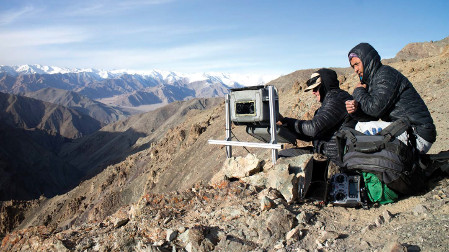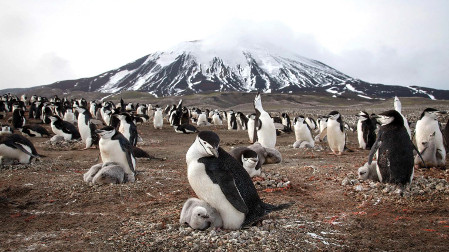Getting Up Close and Personal With the Earth
A decade ago the BBC natural history series, Planet Earth, mesmerized viewers worldwide with some of the world’s most amazing wildlife footage and HD imagery of any kind yet broadcast in HD. On Saturday, 2/18, BBC (America) debuted Planet Earth II, hailed as a milestone in 4K production, (despite being broadcast in HD in North America).

In Ladakh, India, high in the Himalayas, the local team set up and check on a camera-trap, positioned on a route frequently used by snow-leopards crossing these mountains. The camera traps are left out for many months to capture close up shots of these elusive animals.
For BBC, a world leader in natural history production, the time was ripe for a sequel. “It’s been a decade [since ‘Planet Earth’] and we thought it would be interesting to see what has changed since,” said Series Producer Tom Hugh-Jones. Filming techniques, technology, and our understanding of the natural world have moved on significantly since ‘Planet Earth,’ [PE], so the tenth (anniversary) felt like the right time to revisit this classic brand.”
A CLOSER LOOK
Planet Earth II (PEII) has a distinct and different look than PE, which embraced classic “blue chip” natural history production protocol wherein many animals were filmed from a distance, with long, telephoto lenses on large cameras, from hefty tripods and gyro-stabilized cineflex (camera) systems. By contrast, PEII is much more “in your face” with lots of wide angle shots and plenty of camera movement.
“You feel like the camera is moving with the animals,” said Mike Gunton, PEII executive producer. “It’s very fluid, very active. For example, you might see this wonderful lemur leaping through the forest. Before, we’d have filmed that from a distance, but here the lemur almost jumps over your shoulder and you’re moving with it.”
“If you want people to connect emotionally, it’s better for them to feel like they’re in close, within the action, observing thru a wide angle lens, from the animal’s point of view,” added Hugh-Jones.
Get the TV Tech Newsletter
The professional video industry's #1 source for news, trends and product and tech information. Sign up below.
This personal perspective is enabled by a new generation of smaller, often cheaper cameras with 4K sensors which can be deployed in many more challenging situations. Such gear was much more expensive and clunky a decade ago. But the killer app is a new genre of light, ultra-mobile gyro-based camera stabilizers which makes it feasible to literally shoot on the run, and at lower angles than typical human eye level.
“We all tried to get on the animals’ eye level, whether that be a penguin, a crab, or a female bird of paradise which views the male’s courtship display from above,” said Elizabeth White, producer of the first episode, “Islands.”

Chinstrap penguins and their chicks cover the slope of Zavodovski Island, an active volcano in the Southern Ocean. The island is just 9 square miles in size, but it hosts the largest penguin colony on earth—some 1.5 million penguins come here to breed in the Antarctic summer.
However, many PEII sequences intercut tripod-based closeups—many of them using Canon’s 50-1000mm lens (1.5X)—with wide angle mobile shots often done on MoVI stabilizers to blend the best of both methods. One example in “Islands” features hatchling marine iguanas in the Galapagos. “We witness the hatchlings running for their lives moments after hatching,” said Gunton. “The [MoVI-mounted] camera tracks towards them and suddenly a snake emerges from under the camera. Seconds later, there’s another snake and another one and another and then many more. Suddenly we’re running [with MoVI] with about 20 snakes that have been waiting for these iguanas to hatch. They’re literally coming out of the rocks, like something from ‘Indiana Jones;’ truly amazing.” This sequence concludes with a telephoto closeup of two plucky survivors nuzzling each other in brilliant 4K detail.
COMPACT TECHNOLOGY
The recent ability to support smaller cameras on compact, mobile stabilizers and use them to get up close to the animals—often at low angles—underlies the key goals of PEII. “One goal was getting the viewer closer, which meant strategic choices of stories and the technology to image them,” said White. “For ‘Islands,’ many animals like penguins weren’t familiar with humans, and some walked right up to our wide angle cameras for their closeup.”
An underlying goal of PEII was immersion in the animals’ habitat. Key to that was the dramatic evolution in camera technology since PE. “Today cameras are smaller, cheaper and there are really good stabilization systems available for them,” said White. “Now you can put a small, high-quality 4K camera on a drone, or on a handheld gimbal [MoVi/Ronin], or pull it up into the trees on a rope and still get smooth pictures, and give viewers the experience of walking alongside an animal, or being up in a tree with it.”
Most sequences in Islands and in other episodes, also included one or more aerials shot from drones by DJI and others, providing a broader perspective on the animal’s world. “We’re always looking to portray animals in a new light with a different perspective on the natural world,” said Hugh-Jones. “We knew we had to do something different with this series. Our aim was to make the whole event far more immersive, using the new tools now available.” A mere 10 years ago this subjective approach was much tougher to achieve. “‘Planet Earth’ used larger [HD] cameras mounted on large gyro-stabilizers in helicopters, enabling us to zoom in on animals from a kilometer up,” said Gunton. “What we’ve done for ‘Planet Earth II’ is to stick gyro-stabilization inside smaller cameras. The cameras have now come off the tripod and into the hands of cameramen and allow us to get closer to the animals, where helicopters cannot go.
“The visual signature of ‘Planet Earth II’ is keeping the camera very fluid and active, moving with the animals,” Gunton added. “In one episode a lemur almost jumps over your shoulder and as it does, you’re right with it; the camera is running with him.”
6K RED Dragons were widely used in PEII for their ruggedness and dazzling imaging. But their relative compactness also meant they could be stabilized with the new lightweight stabilizers, including MoVI 15s, even when well accessorized. DP Rob Drewett used that combo to capture a vast, fast-moving swarm of locusts.
“To shoot them, I had to keep up with them, so my gear had to be lightweight and agile. The RED EPIC Dragon with a MoVI was perfect. RED’s small form factor let me add accessories like RT Motion follow focus, REDMOTE, a Teradek [wireless video transmitter] and still be free to move around to get some really diverse tracking, jib and dynamic moves that I couldn’t get otherwise,” he said.
Another plus of shooting with Red Dragons in 6K was extra stabilization. “Shooting in 6K enabled me to use post stabilization and still deliver in 4K, future proofing my footage of one of the worst locust infestations ever recorded,” Drewett said.
Miniaturized 4K cameras also allowed the capture of unique footage via remotely-controlled cameras situated where shooters can’t go. “The animals almost operate the cameras, by triggering them as they walk by. Snow leopards are a good example,” said Gunton. “In Planet Earth, we were thrilled to find any snow leopards at all and those were filmed with a long telephoto lens a kilometer away.”
For PEII, the production crew staked out the same locations with dozens of remotely-operated (4K) cameras and filmed them only a few feet away, with some even brushing against the camera, according to Gunton. “In episodes like ‘Mountains’ there is a sense of a really unique and privileged perspective, that only our cameras can reveal,” he said. “We tried to give audiences really original, engaging storytelling by bringing the lives of animals and the places they inhabit to life.”
